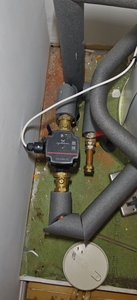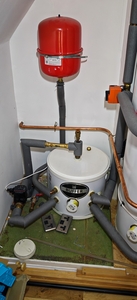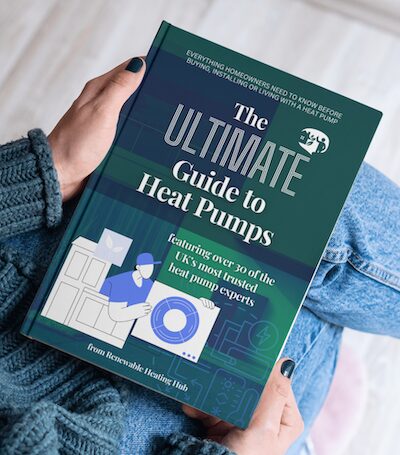Seeking Help for In-Principle Quote to fix a botched heat pump installation by Heat Geek Installer
@drei in your original post, you said:
I'm not guessing, I’ve had an independent assessment from a Heat Geek Elite engineer at the cost of £800, thermal imaging, flow readings, everything documented.
Did the Heat Geek Elite engineer give you a design within the £800 fee, or did he just tell you everything that was wrong and how badly wrong it was?
My impression is that there are 2-3 key problems:
1. The buffer tank is reducing flow temperature to the radiators, so that they never get above 40C.
2. The radiators are inadequately sized, so even at 50C they would not be big enough.
3. The water flow rate might be insufficient to push the water around the radiators fast enough.
Is that correct?
Quote 1 seems to be addressing only part of the problem. If the buffer is plumbed incorrectly (in-flow from heat pump at the top, outflow to radiators at the bottom, return from radiators at the top and return to heat pump at the bottom) then correcting that would certainly help. But removing the buffer entirely might correct it a lot more.
Quote 2 seems to be much closer to what you need. However, I don't understand why you wouldn't upgrade all the radiators that need upgrading. The approach I took was to install big new radiators in the rooms that needed the most heating power. Then, I cascaded the radiators that I had freed up into rooms needing less heating power. Cascading existing radiators down the chain would save you buying so many new radiators, but obviously, they would have to fit in the available space.
Grant Aerona 290 15.5kW, Grant Smart Controller, 2 x 200l cylinders, hot water plate heat exchanger, Single zone open loop system with TRVs for bedrooms & one sunny living room, Weather compensation with set back by room thermostat based load compensation
Posted by: @jamespaPosted by: @dreiI would hope so:) but this is why a Heat Geek Elite quote would really help. I had one booked in but had to cancel last minutes. Just hoping I can get them in this week. This was a free visit.
IMHO hope isnt enough in a situation like this. My strong advice to you is, before you proceed, get the chosen quote validated against either common sense or the report you have.
The person who produced quote number 1 doesn't mention radiator replacements at all, is doing a lot of stuff that will make no difference to your system (although its not bad practice) and appears to be retaining the buffer not converting it to a volumiser or getting rid of it altogether. If he does what he has actually put down put down in writing you very likely wont be much better off and will have blown your 'section 75' option.
Yeah, they did call, and stated that what they intend to do is bypass the buffer, but leave it in place just in case the additional volume is needed, and again, bypass the return so that it goes Radiators ---> Heat Pump, rather than through the buffer.
I did ask him to amend the quote and clarify.
All of the installers are happy using my radiator designs, they stated that they seem solid.
For context, please see attached the actual design, with a shortfall of about 33% per floor, however since my radiators don't get more than 40c at the moment, my shortfall is almost 60%.
These are my designs, and I am using 45 mean water temp, as it is the best of both worlds, so even if I have to go to 50c, it should be much better than my current design. I am trying to keep as many of the existing radiators as I can, in the hope that I can keep the carbon footprint low. Throwing 12 rads away, and the excess electricity used so far, I doubt my heat pump will ever become truly "green".
The only issue is that on the ground floor, I don't have the space for larger radiators, so I have to get a full 3000W electrical radiator, that matches current design.
Please have a look, and let me know your thoughts.
This is my current usage so far, which my installer keeps stating I don't understand how Heat Pump SCOP works, how to work it out and that my readings are wrong:
| MONTH | ASHP kWh | ASHP Output | ASHP SCOP |
| Oct 2023 | 506.5 | 1436.8 | 2.84 |
| Nov 2023 | 1291.9 | 3053.5 | 2.36 |
| Dec 2023 | 1095.9 | 2657.3 | 2.42 |
| Jan 2024 | 1594.5 | 3473.8 | 2.18 |
| Feb 2024 | 1261.8 | 3043.7 | 2.41 |
| Mar 2024 | 896.9 | 2225.5 | 2.48 |
| Apr 2024 | 650.2 | 1245.7 | 1.92 |
| May 2024 | 438.5 | 827 | 1.89 |
| Jun 2024 | 259.9 | 495.4 | 1.91 |
| Jul 2024 | 196.4 | 365.2 | 1.86 |
| Aug 2024 | 156.9 | 297.3 | 1.89 |
| Sep 2024 | 329.6 | 700.2 | 2.12 |
| Oct 2024 | 677.9 | 1318.6 | 1.95 |
| Nov 2024 | 963.5 | 2117 | 2.20 |
| Dec 2024 | 963.9 | 2359.1 | 2.45 |
| Jan 2025 | 1609.6 | 3837.9 | 2.38 |
| Feb 2025 | 1174.8 | 2755.4 | 2.35 |
| Mar 2025 | 847.2 | 1839 | 2.17 |
| Apr 2025 | 535.8 | 1227.7 | 2.29 |
| May 2025 | 337.3 | 796.7 | 2.36 |
| Jun 2025 | 143.8 | 311.4 | 2.17 |
| Jul 2025 | 137 | 317.8 | 2.32 |
| Aug 2025 | 156 | 385.1 | 2.47 |
| Sep 2025 | 296.5 | 748.5 | 2.52 |
| SCOP | 16522.3 | 37835.6 | 2.29 |
This is the problematic 4 pipes buffer. Since I reduced the pump speed, pumping INTO the buffer to L1, the SCOP seems to have improved slightly. I assume it is causing less distortion.
See below my reply to the Buffer Article:
I discovered that my installer’s “50 L minimum water volume” design note, wasn’t a manufacturer requirement but likely a misreading of the Samsung Installation manual (page 29 of the EHS_R-32_MONO_OUTDOOR_IM_EU_DB68-11904A-03_EN.pdf manual) .
Samsung’s own installation guide for my AE120BXYDEG (12 kW, Gen6 R32) states clearly:
Minimum total system water volume = 50 L (radiators, pipework, cylinder coil, and any buffer tank)This means that my system just needs at least 50 L total to run reliably, it does not mean you must add a 50 L buffer tank. In my setup, 19 radiators, a cylinder, and 15–18 m of copper pipe, the system likely already exceeded 50 L without any buffer.
By mistaking “minimum system volume” as “must fit a 50 L buffer,” the installer inflated the system volume unintentionally. That extra buffer tank caused hydraulic distortion, poor ΔT, and system inefficiency, precisely the kinds of failures exposing how buffer tanks are often misused as a crutch for poor design. The buffer tank created operational loss instead of solving it.
Posted by: @drei. The buffer tank created operational loss instead of solving it.
As they almost always do so far as can be judged from this forum (and basic physics).. Based on what I have seen over two years on this forum (and what I have personally experienced) buffers should, IMHO, be banned other than in a truly exceptional case where there there is a proper engineering justification which has been independently verified by someone who understands the issues (much like there were, and possibly still are, things that you cannot do with your pension without first taking independent professional advice).
4kW peak of solar PV since 2011; EV and a 1930s house which has been partially renovated to improve its efficiency. 7kW Vaillant heat pump.
Posted by: @dreiPlease have a look [at the design/rad spec pdfs], and let me know your thoughts.
I get the general idea with the spread sheets, I did something similar, but it is a little difficult just looking at pdfs, as so many things have changed. If you can post the actual spreadsheets (just the relevant worksheets), it will be easier to comment. If not, just add your own sense check check sums.
One general comment for now (I also had limited wall space) - can you use more K3s, and get rid of that 3000W electric radiator monster? K3s are large - almost all of mine are K3s - but if placed between furniture the protrusion is less obvious, and over time you sort of get used to them.
Midea 14kW (for now...) ASHP heating both building and DHW
Posted by: @cathoderayPosted by: @dreiPlease have a look [at the design/rad spec pdfs], and let me know your thoughts.
I get the general idea with the spread sheets, I did something similar, but it is a little difficult just looking at pdfs, as so many things have changed. If you can post the actual spreadsheets (just the relevant worksheets), it will be easier to comment. If not, just add your own sense check check sums.
One general comment for now (I also had limited wall space) - can you use more K3s, and get rid of that 3000W electric radiator monster? K3s are large - almost all of mine are K3s - but if placed between furniture the protrusion is less obvious, and over time you sort of get used to them.
I tried to add the workings on the PDF, as I realised there is no formula. I can duplicate my spreadsheet as everything I have is on Google Sheets. Kept it that way for easy access across devices.
I think in principle my design is OK.
In regards to changing the rads, if I replace 19 rads with Panel K2 and K3, it will definitely work, but that means £6000+ just in radiators, and I would have to throw away at least 15 rads, less than 2 years old, maybe I can sell them, but for the headache, it would probably be easier to load them in a truck and take them to the scrap iron or the recycling centre, which will be a huge carbon footprint (yep I am still thinking of that, as that was the whole point of the heat pump).
I was hoping to still keep the designer look, as they are nice, and my wife really hates the panel rads, and only upgrade to K2 and K3 where necessary without having a choice.
As a last minute resort, I may just have to go via the full panel upgrades, and only use the double column vertical rads, to replace the existing towel rads.
Posted by: @drei£6000+ just in radiators
That is a lot for just rads, I think if you got trade prices on standard K3s you could cut that down a lot, plus scrapping metal these days is actually recycling it, not going into landfill.Only you and your wife can decide whether the extra dosh is worth the designer look.
Midea 14kW (for now...) ASHP heating both building and DHW
@drei I think someone else mentioned that you could just replace the biggest radiator and cascade the others down to different rooms. I did it saves a packet
House-2 bed partial stone bungalow, 5kW Samsung Gen 6 ASHP (Self install)
6.9 kWp of PV
5kWh DC coupled battery
Blog: https://thegreeningofrosecottage.weebly.com/
Heatpump Stats: http://heatpumpmonitor.org/system/view?id=60
Posted by: @dreiSee below my reply to the Buffer Article:
I discovered that my installer’s “50 L minimum water volume” design note, wasn’t a manufacturer requirement but likely a misreading of the Samsung Installation manual (page 29 of the EHS_R-32_MONO_OUTDOOR_IM_EU_DB68-11904A-03_EN.pdf manual) .
Samsung’s own installation guide for my AE120BXYDEG (12 kW, Gen6 R32) states clearly:Minimum total system water volume = 50 L (radiators, pipework, cylinder coil, and any buffer tank)This means that my system just needs at least 50 L total to run reliably, it does not mean you must add a 50 L buffer tank. In my setup, 19 radiators, a cylinder, and 15–18 m of copper pipe, the system likely already exceeded 50 L without any buffer.
By mistaking “minimum system volume” as “must fit a 50 L buffer,” the installer inflated the system volume unintentionally. That extra buffer tank caused hydraulic distortion, poor ΔT, and system inefficiency, precisely the kinds of failures exposing how buffer tanks are often misused as a crutch for poor design. The buffer tank created operational loss instead of solving it.
You are correct that the Samsung docs recommend a minimum system volume of 50L, but note the key word there is minimum. In reality, the system volume should be significantly larger.
I have the 12kW Samsung gen6 ASHP, and our system volume is ~190L, comprising ~45L in the system pipework, ~95L in the radiators and a 50L volumiser (not buffer). So even with 140L native system volume, we still have a 50L volumiser. The additional volume gives higher thermal mass which should in theory help with short cycling, but most importantly in my opinion it ensures there is sufficient heat energy in the system to adequately perform system defrosts in winter. If you do not have sufficient heat in the system, it is possible to descend into a defrost spiral sucking all the heat from the system, with the heat pump then working flat out replacing it only to entering another defrost cycle...
See this thread and the YouTube video in the first post.
Samsung 12kW gen6 ASHP with 50L volumiser and all new large radiators. 7.2kWp solar (south facing), Tesla PW3 (13.5kW)
Solar generation completely offsets ASHP usage annually. We no longer burn ~1600L of kerosene annually.
- 26 Forums
- 2,356 Topics
- 53.4 K Posts
- 339 Online
- 6,017 Members
Join Us!
Worth Watching
Latest Posts
-

RE: Controlling Daikin Altherma via P1P2 and Home Assistant
On the contrary, @toodles, that’s a lot of help. I’d ne...
By Majordennisbloodnok , 2 hours ago
-
RE: Octopus Cosy Heat Pump Owners & Discussion Thread
@kevh with the Cosy 6 I know it definitely goes to arou...
By HarrisonC , 14 hours ago
-
RE: Setback savings - fact or fiction?
@cathoderay yes I am familiar with SQL. Interesting num...
By RobS , 15 hours ago
-

Parsnip, Bacon & Coconut Milk Soup
First let me say, I am only a cook because I am human a...
By Toodles , 15 hours ago
-
RE: Electricity price predictions
Ben Watts posted on LinkedIn that he had updated this w...
By Judith , 21 hours ago
-

RE: The good, the bad and the not that great – my heat pump installation
Small update, Emailed and Spoke to Midea UK and they ...
By Burtis , 21 hours ago
-
RE: Solis S6-EH1P8K-L-PLUS – Why I Chose It and What I’ve Learned So Far
@bash Octopus does charge for the admin. The process al...
By Batpred , 21 hours ago
-
RE: External pipework insulation
@transparent HI all The products you mention are ver...
By David Smith , 21 hours ago
-
RE: New Fogstar 15.5kWh upright solution
Issues still under investigation by Solis... Fogstar ...
By Batpred , 22 hours ago
-
RE: Who's your electricity provider and what's your tariff?
I agree, the consumer is not being properly represented...
By Batpred , 22 hours ago
-
RE: Advice on internal circulation pump noise
Thanks @mikefl - I'll maybe have a look at the lock-shi...
By jtg , 2 days ago
-

RE: Heat Pump Heats the House… But It’s Not Cosy. Emitter Changes or System Tweak?
@toodles interesting suggestion, thanks. I will try to...
By GrahamF , 2 days ago
-
RE: Mitsubishi Ecodan Auto Adaption trial to stop cycling.
The interval you talk of, i think, will be 60min for an...
By F1p , 2 days ago
-
Agree with @majordennisbloodnok on the setbacks. We hav...
By ChandyKris , 3 days ago
-

RE: Speedcomfort radiator fans
@deltona the way the links were added broke the page. A...
By Mars , 3 days ago
-

RE: Refrigerant R32, is it now banned in the EU from 1st Jan 2027 for monobloc ASHPs?
This has been delayed from what I believe to be this ye...
By dgclimatecontrol , 3 days ago
-
RE: Are We Sleepwalking Into Another Race to the Bottom?
this is why I provided current flow temperatures in the...
By ksim , 3 days ago
-

RE: Why Millions of UK Homes Struggle With Heat Pumps
There's many homes that would be quite a disruption for...
By dgclimatecontrol , 3 days ago







